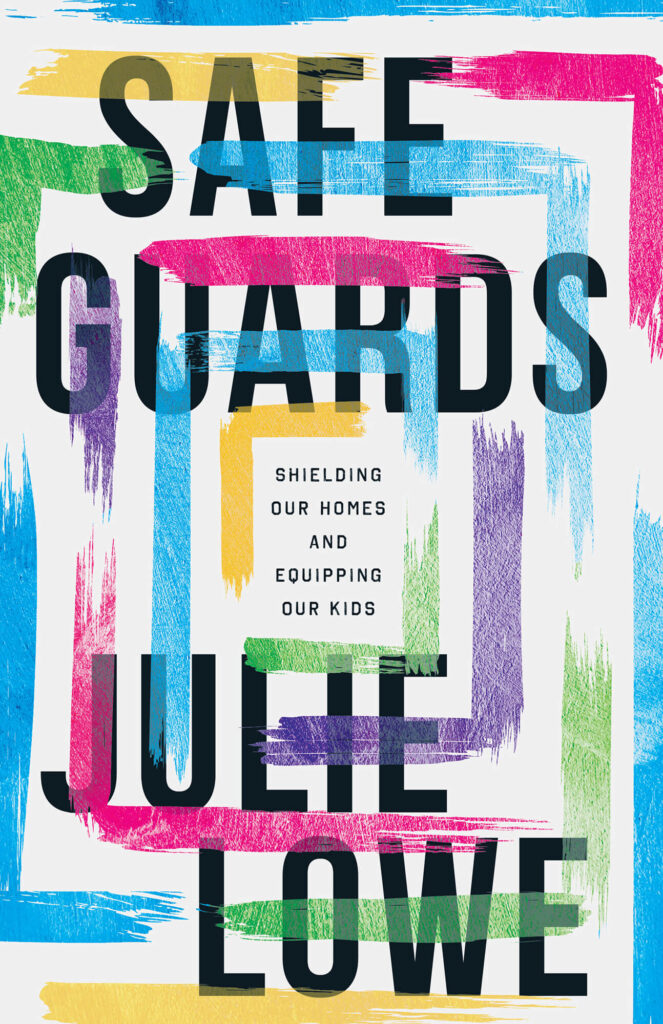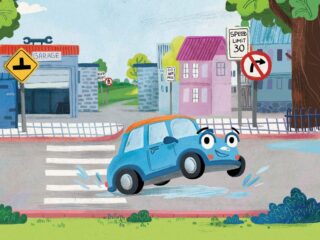The world can be a scary place, but we can help our children feel confident and prepared rather than growing up scared or being sheltered from the potential dangers that surround them. After more than two decades as a family counselor, Julie Lowe has seen how important it is to help parents and caregivers think wisely and biblically about the potentially harmful situations children face. Instead of living in fear or denial, parents and caregivers can equip children to assess people and situations and model for them how to live by faith in a world where evil exists.
In Safeguards: Shielding Our Homes and Equipping Our Kids, she helps parents and caregivers teach the safety skills that will help protect their children from mistreatment, unsafe situations, violence, bullying, cyber-crimes, predatory behavior, sexting, abuse, and other kinds of danger that they might encounter. The skills needed at every stage—preschool, elementary age, teens, and college-bound—are discussed and applied in an age-appropriate way.
In this interview with Julie, we talk more about Safeguards.
Q: What are some of the unique dangers that children face today?
There is nothing new under the sun, so we face the same dangers as our parents did 40+ years ago. But because of today’s culture and technology, the easy access and the way kids are exposed to the dangers is different. Young people are now more aware of the perils of the world they are surrounded by (such as school shooters and terrorism). They are also facing these dangers on a more regular basis.
All it takes is less than an hour of watching the local news to become aware of the dangers that our children confront every day as they go out into the world. Consider some of these common risks to young people:
- Rising reports of youth depression, suicide, and anxiety
- Marijuana and drug use becoming more commonplace
- Bullying and cyberbullying increasing with modern technology
- Younger and younger children being exposed to pornography, sexting, and solicitation
- Sexual activity, orientation, and identity issues on the rise
- Internet and online addiction
- A growing culture of violence, objectification, and desensitization to the mistreatment of others
- Physical abuse, sexual abuse, date rape, and trafficking of young people
- School shootings, teens encouraging other teens to commit self-harm, and dangerous viral social media challenges
Q: You write that parents need to address and respond to safety issues regarding their children with an appropriate dose of both realism and faith. Can you explain more about what that balance might look like?
We live in a broken world, and our children need to be equipped to live in this reality. Rather than react out of fear, we must help our kids by demonstrating an appropriate level of sobriety and sorrow when faced with these facts, while also exhibiting that our hope is in Christ. The challenge is to find the right balance—teaching young people awareness and caution, while equally encouraging trust in a sovereign God. Young people must learn to live life fully and not be overshadowed by fear.
So parents—engage with your kids about these threatening realities. Do your best to explain them and be willing to discuss why evil exists. Model godly grief and educate your children on what is right and just. Our kids will be able to walk with confidence in a troubled world if they are educated on how to think, feel equipped to respond, and have grown to put their confidence in their Creator. We want to teach children how to both navigate this world and trust an unrivaled God.
Q: What is the difference between equipping kids and raising fearful kids?
Let’s remember that we are called to raise equipped kids, not fearful kids. We can educate our children about the dangers that exist without teaching them to respond with or live in fear. As I think about my experiences as a parent and counselor, I would maintain that the more children are trained and given the tools to know how to respond to uncertain or dangerous situations, the more confident, competent, and prepared they will be.
Raising equipped kids means they are aware of temptations and dangers, but they’re given the tools and resources to know how to respond to them while also being safeguarded. We do this by teaching discernment, the ability to know right from wrong. A fearful child is afraid to try anything, paralyzed by the fear instilled in them. An equipped child knows God is their help and they can navigate the world through this lens.
Q: What are some of the best strategies to teach these skills to kids? How do parents prepare their children to put these skills into practice?
Deuteronomy 6 encourages us to teach what is good and right to our children as we go about life. We are to teach them diligently—talking with them when we sit and when we walk and when we lie down and when we rise up (Deuteronomy 6:7). We cannot always keep our children from exposure to evil or temptation, but we can equip them to respond to situations with wisdom and discernment.
Wherever you are—out at Target, walking down the street, or spending time at home, are you giving kids the chance to evaluate situations? Role-play various scenarios and rehearse what they would do if faced with certain situations. This gives them the practice to distinguish good from evil.
Q: Safeguards is divided between equipping children and equipping teens and young adults. What are some of the topics you address for each age group?
For younger children, I talk about the importance of practicing through role-playing, teaching kids to evaluate the behavior of those around them, how to be smart with technology, and what to do in the case of bullying. There are also chapters about what to do if they get lost or someone makes them uncomfortable, creating family safe words and safety plans, offering guidelines for childcare and sleepovers, and how to respond when violence touches your child’s life.
For teens, I talk about more serious topics they are now more aware of, such as peer pressure, treating others with respect, gender issues and sexuality, vaping, smoking, mental health issues, navigating relationships, technology, social media, pornography, and sexting.
As teens head into young adulthood, we talk about how to wisely navigate being on their own, traveling, independence, college campus life, and online dating.
Q: Protecting children from sexual abuse is one of the most important and sensitive situations discussed. Most of the time the abuser is someone known to the child, so what are some warning signs to be aware of, without being paranoid about everyone you know?
As a parent, I want to be aware of who has access to my child and why. And when I see someone focused on one of my kids, I want to know what their purpose is. Are they ever alone with my child? How familiar is this person with my child? Are there natural reasons for this? The answers may not be immediate, but noticing will help us be more aware and discerning.
Some of the signs of grooming to look for is if someone is becoming affectionate with my child, giving them gifts, and spending time alone with them. It’s not to assume everyone has ill intentions, but it is vital to pay attention to why these dynamics are occurring because it could expose an inappropriate dynamic.
So a key principle is to pay attention! If you notice things are amiss, give yourself permission to pay attention, to notice, and to acknowledge that something feels a bit off to you. You’re not judging, you’re trying to be attentive. Your child’s safety is of the utmost importance.
A common maxim is making sure a child “never feels uncomfortable,” but this doesn’t give kids the chance to discern or evaluate what makes them uncomfortable. Why do you not like to hug grandma? Is it because she smells like moth balls and you don’t like it, or is it because she hugs you in a way that bothers you? We want to evaluate when to press into things that make us uncomfortable and when it is a sign of danger. Is it a healthy, wise, and good thing to do, even if it makes them uncomfortable?
Q: We often talk to kids about stranger danger and tell them not to talk to strangers, but you urge parents to look at the stranger discussion differently. Can you tell us about how you have taught your own children how to talk to strangers?
I told my kids strangers are not dangerous; dangerous people are dangerous. This can be people you know or don’t know. How do you know who is dangerous? Look at their behavior and evaluate their actions.
We teach our kids how to talk to strangers. Should they ever be lost or need help, they will need to be able to approach someone they don’t know to get help. We do not want our kids to be afraid of strangers; we want them to be equipped around strangers. There may be situations where they need to approach a stranger and ask for help, and they need to know what is appropriate to share or not share.
Q: Why is it important to teach our children to evaluate behavior instead of evaluating character? How do you teach discernment to children?
We are notoriously bad at reading people’s character, and people lie and deceive. Deceptive people present themselves as good and trustworthy. I can’t see into someone’s heart, but I can see their behavior and evaluate it. If I teach my kids to evaluate words and actions, they don’t have to evaluate the person as good or bad.
So how do you teach discernment? It goes back to Hebrews 5:14 which discusses that the mature “have their powers of discernment trained by constant practice to distinguish good from evil.” Discernment involves observing what is happening in the moment and trying to identify what you are seeing. It picks up on many cues, details, and facts about a situation. It can help you perceive if something wrong or unsafe is happening, even if you cannot immediately articulate it in the moment.
As we teach our children good from evil, they need to practice asking whether what they’re being asked to do is good and right. Is a teacher, sibling, etc. asking your child to do something wrong? If so, then they don’t have to comply, and you as parents will support your child in this.
Q: In your book you talk about being willing to bring up hard topics, even when it feels like the issues may not be relevant to them yet. Why is that?
You always want to be proactive, not reactive. You want to proactively shape your children’s thoughts about topics so they won’t be scared later. Sometimes we assume our kids will have a big reaction or be thrown by things when they may not. Kids who grow up in safe homes tend to not be fearful of danger but instead are unaware of it. We don’t want to take away all of their naivety and innocence, and we don’t want to create fear and worry either.
Here’s the key: How parents talk about dangers matters. Children will be prepared for when they encounter these things and they can be taught in a way that will help them not be afraid. You want to proactively shape them so they have tools and resources to know how to think about it and not fear in the moment.
It is important to use child-appropriate language. It is also wise to know your child, and where they might or might not be fearful about different things. But you always want to be proactively shaping your child so that they have the tools to think about what life will bring.
Safeguards: Shielding Our Homes and Equipping Our Kids
Julie Lowe helps parents and caregivers teach the safety skills that will help protect their children from mistreatment, unsafe situations, violence, bullying, cyber-crimes, predatory behavior, sexting, abuse, and other kinds of danger that they might encounter. The safety skills that are needed at every stage—preschool, elementary-age, teens, and college-bound—are discussed and applied in an age-appropriate way.






